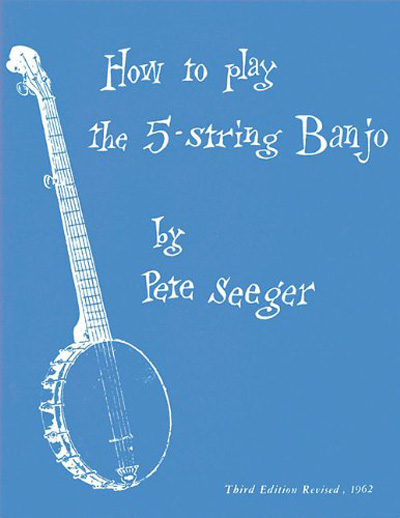
When I was a kid, my parents bought me a banjo. I had been playing ukulele for several years and had started playing guitar. But I was strictly a rhythm guitar player. I had no fingerpicking skills. When I started trying to play the banjo, I quickly became frustrated. I never felt comfortable enough with my technique to even begin to develop any speed. The books I was using to learn were either to simple or confusing. The book that I had that I didn’t pay any attention to was Pete Seeger’s “How to play the 5-String Banjo”. At the time, I barely knew who Pete Seeger was. The book focused on simple techniques and styles that I didn’t really want to play. I was a big Steve Martin fan and I wanted to play bluegrass like him. I also wanted to play like Earl Scruggs. How would I ever learn to play like them?
The answer was that I wouldn’t. At the time, I would never get comfortable with the instrument to enjoy playing it. It sat in a corner in my room until sometime later when a cousin borrowed it to try and learn.
Fast forward to 2006. My son had an electric guitar that I had started playing quite a bit. I bought the acoustic guitar that I have now. After a while, I learned to fingerpick a few songs. Pretty soon I learned a technique that I was comfortable with and enjoyed playing. It gave me enough confidence to think that I might be able to actually play a banjo. I didn’t want to make a huge investment in an instrument that I was afraid I would fail on again. I purchased an inexpensive banjo. And a couple of books. First I purchased “Earl Scruggs and the Five String Banjo” because I wanted to learn from the master. And I bought a new copy of the Pete Seeger book.
“………can I read notes? Hell, there are not notes to a banjo, You just play it.“
Reply made by an old-time banjo picker, interviewed around 1850, and asked if he could read music
Why? I had learned more about Pete and his philosophy of music. His approach to singing was to get his audience to sing. You didn’t go to one of his shows to listen, you went to participate. The songs he wrote and songs from other artists that he chose to perform were simple and written in a way that they encouraged you to join in just from the way they sounded. His technique was simple and non-intimidating. His manner was such that you wanted to join in. This attitude toward singing also went for playing banjo. Pete had confidence that everyone should be able to play and you weren’t going to let him down by not doing your best to do all that you could. He wasn’t expecting much from anyone and whatever you did would be what he wanted you to do. As long as you did something. Any everyone loved Pete enough to do something. If you knew you couldn’t sing, you would at least try to clap in time to do your part. And that was good enough for him. This is what I got from the book.
I didn’t use his book much for technique, but I did use it for encouragement and attitude. It gave me the added confidence to be comfortable with my skill level on banjo. This time, I would be able to play and have fun. This time, I would play well enough to actually play for other people. This time, I would actually record a banjo part for one of my songs. If you listen to the song The Tree of Life from my Six Minutes After Seven album, you will hear a banjo playing. Not any lightning fast licks like Earl Scruggs. Just simple picking, more like what you would expect to hear from Pete Seeger.